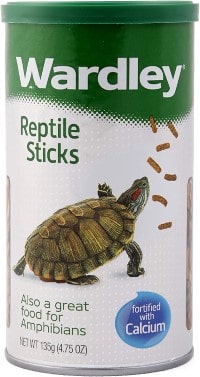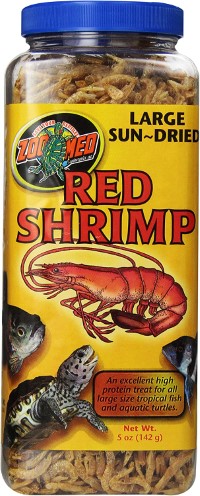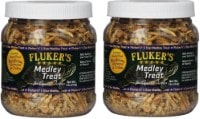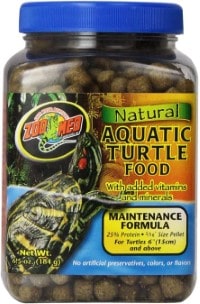A turtle can be your best friend for a very long time. However, as they are a bit picky about their food habits, you should make sure to offer them the best turtle food you can. Otherwise, they could fall victim to malnutrition or disease.
As well as offering them fresh veggies and fruits, you should add all-round commercial food too. These commercial foods often contain a wide variety of top-quality ingredients which may be too difficult to find at home or in the store.
That being said, let’s take a look at the best turtle food you can find in 2020. Also, don’t forget to check out the buying guide section if you are new to this.
| IMAGE | PRODUCT | DETAILS | rating | price |
|---|---|---|---|---|
Best Overall | Tetra Reptomin Floating Food Sticks for Aquatic Turtles |
| ||
Best Premium | Rep-Cal Maintenance Formula Box Turtle Food Fruit |
| ||
Best Budget | Wardley Premium Amphibian and Reptile Sticks |
| ||
 | Royal Pet Supplies Inc Zoo Med Sun Dried Large Red Shrimp |
| ||
 | Fluker Labs SFK72020 Aquatic Turtle Medley Treat Food |
| ||
 | Zoo Med Laboratories 2 Pack of Natural Aquatic Turtle Food |
|
The Best Turtle Food in 2020
Tetra Reptomin Floating Food Sticks for Aquatic Turtles – Best Turtle Food
![The Best Turtle Food On The Market [Review and Buying Guide] 1 Tetra-ReptoMin-Floating-Aquatic-Turtles-full](https://animalfella.com/wp-content/uploads/2020/06/Tetra-ReptoMin-Floating-Aquatic-Turtles-full-503x1024.jpg)
When it comes to aquarium care, Tetra is a brand you simply can’t ignore. Their best in class Tetra Reptomin Floating Food Sticks for Aquatic Turtles is one of the most popular amphibian foods.
There is a strong reason behind the hype.
It’s a rare product that offers the right quantity and balance of the nutrients. You get amino acids in addition to protein, calcium, and vitamin C.
Also, the floating sticks are very easy to digest.
Rather than going for processed ingredients, Tetra has combined a wide variety of natural ingredients, such as fish and shrimp.
All these traits make this product the best turtle food on the market right now.
Notable Features
- A balanced diet designed for turtles, newts, and toads
- Floating sticks mimic natural foraging and hunting
- Contains the optimum amount of protein, calcium, and vitamin C
- Easy to digest formulation
- Made from natural ingredients
- Contains amino acids
- Comes in five different packaging options
Guaranteed Analysis
- Crude Protein (Min.): 42.5%
- Crude Fat (Min.): 8.5%
- Crude Fiber (Max.): 2.0%
- Moisture (Max.): 8.0%
- Phosphorus (Min.): 1.8%
- Calcium (Min.): 2.0%
- Vitamin C (Ascorbic Acid): 100mg/kg
Rep-Cal Maintenance Formula Box Turtle Food Fruit – Best Premium Turtle Food
![The Best Turtle Food On The Market [Review and Buying Guide] 2 repcal-maintenance-formula-box-turtle-food-fruit-full](https://animalfella.com/wp-content/uploads/2020/06/repcal-maintenance-formula-box-turtle-food-fruit-full-608x1024.jpg)
Do you have a box turtle in your terrarium? Therefore, you will need to take extra care when feeding them.
Box turtles can appear famished when they eat. That’s why it’s very easy to overfeed them. Also, you need to offer them a complete diet made up of both plant- and animal-based food.
This is where the Rep-Cal Maintenance Formula Box Turtle Food Fruit comes to the rescue.
It has a unique formulation which contains a lot of natural ingredients. Most of these are plant and fruit extracts with a slight addition of mealworms and earthworms.
Overall, it’s a great option with an abundance of vitamins and minerals.
Notable Features
- Pellets made from natural ingredients
- A totally complete diet
- Enriched with vitamins and minerals, particularly calcium and vitamin D3
- All pellet grains are uniform
- A daily diet option
- Comes in two packaging options
Guaranteed Analysis
- Crude Protein (Min.): 28%
- Crude Fat (Min.): 2%
- Crude Fiber (Max.): 12%
- Moisture (Max.): 12%
Wardley Premium Amphibian and Reptile Sticks – Best Budget Turtle Food
![The Best Turtle Food On The Market [Review and Buying Guide] 3 wardley-premium-amphibian-and-reptile-sticks-full](https://animalfella.com/wp-content/uploads/2020/06/wardley-premium-amphibian-and-reptile-sticks-full-543x1024.jpg)
Who said that keeping your turtles healthy and strong has to be expensive? There are a lot of options for budget-friendly turtle foods on the market.
Among these, Wardley Premium Amphibian and Reptile Sticks is the best one you can get your hands on.
Yes, this is a premium turtle food, but it’s quite easy on your wallet.
And, no, it’s not a poor quality turtle food. In fact, you get floating sticks, which are more expensive to produce, together with protein, calcium, and vitamin C.
The key ingredients of Wardley turtle food are fish meal and poultry by-product, so it contains a high protein percentage.
As well as offering a ton of minerals, it’s rich in vitamin C, Vitamin A, vitamin B12, and vitamin D3 supplement.
Notable Features
- Premium quality floating sticks
- Made for turtles, frogs, newts and other similar amphibians
- Rich in nutritional value
- Designed to appeal to picky eaters too
- A completely balanced diet
- Comes in three size options
Guaranteed Analysis
- Crude Protein (Min.): 39.0%
- Crude Fat (Min.): 9.0%
- Crude Fiber (Max.): 3.5%
- Moisture (Max.): 10.0%
- Phosphorus (Min.): 1.1%
- Calcium (Min.): 1.5%
- Vitamin C (Ascorbic Acid): 250mg/kg
Royal Pet Supplies Inc Zoo Med Sun Dried Large Red Shrimp – Best for Carnivore Turtles
![The Best Turtle Food On The Market [Review and Buying Guide] 4 Zoo-Med-Dried-Shrimp-5-Ounce-full](https://animalfella.com/wp-content/uploads/2020/06/Zoo-Med-Dried-Shrimp-5-Ounce-full.jpg)
Here’s an important piece of information: turtles love shrimps!
What if you could feed whole shrimps to your turtles? Wouldn’t that be great?
In that case, you should thank Zoo Med Sun Dried Large Red Shrimp, because the key ingredient in this food is whole red shrimps (Solenocera melantho).
You can also use it as their staple food.
It offers a very high quantity of protein. You can offer this treat to them two to three times a week. You can use it as a daily meal if you mix it with different insects and leafy greens.
Notable Features
- Contains only sun-dried red shrimps
- Very rich in protein
- Perfect for carnivore turtles
- Increases muscle build, weight, and activity in turtles
- Comes in eight different size options
Guaranteed Analysis
- Crude Protein (Min.): 59.0%
- Crude Fat (Min.): 8.5%
- Crude Fiber (Max.): 3.5%
- Moisture (Max.): 9.0%
Fluker Labs SFK72020 Aquatic Turtle Medley Treat Food – Best Turtle Food for Red Eared Sliders
![The Best Turtle Food On The Market [Review and Buying Guide] 5 fluker-labs-sfk72020-aquatic-turtle-medley-treat-food-full](https://animalfella.com/wp-content/uploads/2020/06/fluker-labs-sfk72020-aquatic-turtle-medley-treat-food-full.jpg)
Fluker Labs SFK72020 Aquatic Turtle Medley Treat Food follows almost the exact same philosophy as the previous option.
This food contains whole dried insects, but rather than relying solely on sun-dried red shrimps, Fluker Labs has created a combination.
This combination includes freeze-dried river shrimps, mealworms, and crickets.
So, in a way, it’s another natural food source for your turtles, but it’s actually a medley treat food. This means that you should only offer this food to your turtles occasionally or mix it with other ingredients.
Notable Features
- Contains only freeze-dried river shrimps, mealworms, and crickets
- Very rich in protein
- Perfect for carnivore turtles
- Increases muscle build, weight, and activity in turtles
- Comes in only one size option (two x 1.5-ouncs jars)
Guaranteed Analysis
- Crude Protein (Min.): 58.0%
- Crude Fat (Min.): 12.0%
- Crude Fiber (Max.): 7.0%
- Moisture (Max.): 8.75%
- Phosphorus (Min.): 2.75%
Zoo Med Laboratories 2 Pack of Natural Aquatic Turtle Food (Maintenance Formula) – Best Baby Turtle Food
![The Best Turtle Food On The Market [Review and Buying Guide] 6 zoo-med-laboratories-2-pack-of-natural-aquatic-turtle-food-full](https://animalfella.com/wp-content/uploads/2020/06/zoo-med-laboratories-2-pack-of-natural-aquatic-turtle-food-full-673x1024.jpg)
Zoo Med Natural Aquatic Turtle Food has three variants based on different protein levels: hatchling, growth, and maintenance.
I am talking about the maintenance variety here. Once your turtle has grown up a bit and requires less frequent feeding and a less protein-rich diet, you can offer them this food.
This doesn’t mean that you can’t offer it to young turtles though, because it is also suitable for them.
When feeding this food to younger turtles, you should make sure to crush it a bit as the chunks can be a bit large. However, as it’s a floating pellet, they will eat this food with pleasure.
Notable Features
- Floating pellets
- A balanced daily diet option
- Rich in vitamins and minerals, particularly calcium and vitamin D3
- All pellet grains are uniform
- Comes in only one packaging option (a two-pack of 6.5-ounce jars)
Guaranteed Analysis
- Crude Protein (Min.): 25.0%
- Crude Fat (Min.): 5.0%
- Crude Fiber (Max.): 8.0%
- Moisture (Max.): 11.0%
- Calcium (Min.): 1.3%
- Phosphorus (Min.): 1.0%
- Vitamin C: 90mg/kg
Buying Guide: Things to Consider When Choosing the Best Turtle Food
When you go on a diet, what do you normally do?
You check the nutritional value of every food before every meal and count your calorie intake, right?
In exactly the same way, you should consider the nutritional value of food before giving it to your precious little pet.
For example, you should pay attention to how much protein content the food has or whether it contains artificial ingredients or only natural ingredients.
This may seem a little confusing, but trust me, it’s quite easy.
You just need to check the guaranteed analysis on the packaging before you make a decision.
These are the most important factors you should focus on:
Protein Content
Turtles are omnivores, so they need to eat both greens and protein every day.
If the growth and health of your turtles is the main focus for you, you should pay extra attention to protein intake.
Protein will help your turtles to gain steady growth, heal better, and live a healthier life.
So, what is the ideal value?
Somewhere around 40% crude protein or higher is perfect.
Check the label, and you can read the guaranteed analysis of the food. As well as the protein content, you should also look at fat intake.
This should be around 10%.
Calcium and Vitamin C
Calcium is one of the most essential nutrients for a turtle.
A lack of calcium can lead to calcium deficiency. As a result, turtles’ shells might soften up. Also, your female turtles could encounter difficulties when laying eggs.
Therefore, adding calcium to their diet is an absolute must.
As turtles are amphibians, their terrarium should contain both water and dry areas. Such an environment can invite different kinds of infection. Shell infections and respiratory infections are two of the most common diseases which are seen among turtles.
What’s the solution here?
Vitamin C.
You absolutely must add Vitamin C to their diet.
Most good brands add around 100mg/kg ascorbic acid to their turtle food.
Natural Ingredients
The more natural you can keep a turtle’s diet, the better. In the wild, turtles eat different kinds of small fish, insects, shrimp, and a variety of plants.
Try to buy turtle food which reflects such a combination.
You can find out about the raw ingredients of a food by reading the packaging.
In my experience, some of the best natural ingredients include shrimp, fish meal, poultry by-product meal, soybeans, and corn.
Floating Food
When choosing food for your turtles, it’s better to go for the option that floats. In a wild environment, turtles swim on top of the water’s surface and eat.
So, if your food (pellets or sticks) floats on the water surface, it will be easier for your turtles to consume it.
Pellets vs Sticks: Which is the Best Option?
Most commercial turtle foods come in two shapes: sticks and pellets.
From a nutritional perspective, both are nearly identical. They both contain crude protein, fat, fiber, and moisture.
Even the percentages of their nutritional values are very close to one another.
So, is there any difference?
Only the shape.
Pellets are typically small, and sticks are larger in size.
Due to their size, pellets are easy to consume. On the other hand, sticks are large, and they’re easier to notice. If your turtles see you tossing these sticks in turtle tank, they will understand that it’s feeding time.
In this way, you can control your turtles’ nutrient intake, and they will remain healthier.
However, not every turtle will prefer stifcks, due to the size of them.
Therefore, it’s better to leave this decision to your turtles. Offer them both pellets and sticks, and you’ll soon learn which one they prefer the most.
More: Betta Food Guide
How Often Should You Feed Pet Turtles?
The feeding habits of turtles depends entirely on their age.
If you have a young turtle, you’ll have to offer them frequent food which is rich in calcium and vitamins. Younger ones require extra nutrition in order to strengthen up their shells.
I suggest feeding them daily with a protein-rich diet. As they are more active in the morning and in the evening, that is the ideal feeding time.
You should then increase the calcium and vitamin quantity three times a week.
An older turtle, on the other hand, eats much less frequently. They either eat very little every day or have a large portion every third day.
You should be extra careful when providing food to them. If you offer them too much food, they will waste most of it. This will increase the amount of decaying material in their habitat, which can lead to the creation of a hazardous environment.
There are some breeds which go into hibernation and will not consume anything during that period. Box turtles fall into this category.
I suggest using the trial-and-error method in order to find the perfect feeding schedule. You will gain a clear idea within a month, but you should always make sure to remove any extra uneaten food after each meal.
More: Goldfish Food Guide
How Much Turtle Food Should You Use?
Now that you know about feeding schedules, you should also learn about the right quantity to feed turtles for every meal.
Again, you’ll need to rely on the good old trial-and-error method.
Why is that?
Because every species of turtles consumes a different amount of food.
Try gradually offering them food for about 15 to 20 minutes. They will actively eat for this long. After that, they lose their appetites.
After following this feeding strategy for a few days, you’ll get a good idea of how much your turtle will eat in a single meal.
In this way, you can minimize food wastage and keep your turtle tank clean.
What Can Turtles Eat Besides Turtle Food?
You are probably relying on commercial turtle pellets and sticks, but you should also offer some variation to keep them healthy and satisfied.
As turtles are omnivores, you should offer them vegetables every now and then. Relying only on commercial food is never a good decision.
Try using colorful vegetables, for example, carrots, green beans, sweet potatoes, lettuce, and leafy greens.
You can also offer them fresh fruit. Turtles love green and red apples, strawberries, cucumber, papaya, and raspberries.
Younger turtles have a fondness for small aquatic animals. They love taking a bite of earthworms, tadpoles, small fish (guppies), or snails, so you can offer them such high protein animals too.
Remember, the key is to offer variation. Turtles can become quite bored if they only eat commercial foods.
What Foods Should You NOT Feed Your Turtle?
Just because turtles are omnivores, you should not just give them anything you can find at home to eat. Some foods can be very dangerous for them.
Consider spinach, for example. You might think that spinach would be a great option for them, but it’s not. Spinach interferes with their calcium intake.
Similarly, you must avoid giving them citrus fruits, even though they are rich in vitamin C.
That’s not good at all.
Here is a list of foods you shouldn’t give to turtles:
- Milk or cheese (any kind of dairy product)
- Spinach
- Citrus fruits such as oranges or lemons
- Onions, garlic, or shallots (or other similar bulbs)
- Pepper
- Chocolate
- Potatoes
Conclusion
So, let’s focus on the important question – what is the best turtle food?
As a complete all-round option, Tetra Reptomin Floating Food Sticks for Aquatic Turtles takes first place.
Next comes Rep-Cal Maintenance Formula Box Turtle Food Fruit. It would have been the number one option if it were a little bit cheaper.
Finally, Wardley Premium Amphibian and Reptile Sticks takes third spot as the best value option.
What do you think?

![The Best Turtle Food On The Market [Review and Buying Guide] 7 William Rieder](https://animalfella.com/wp-content/uploads/2022/10/william-rieder-profile-photo.jpg)
